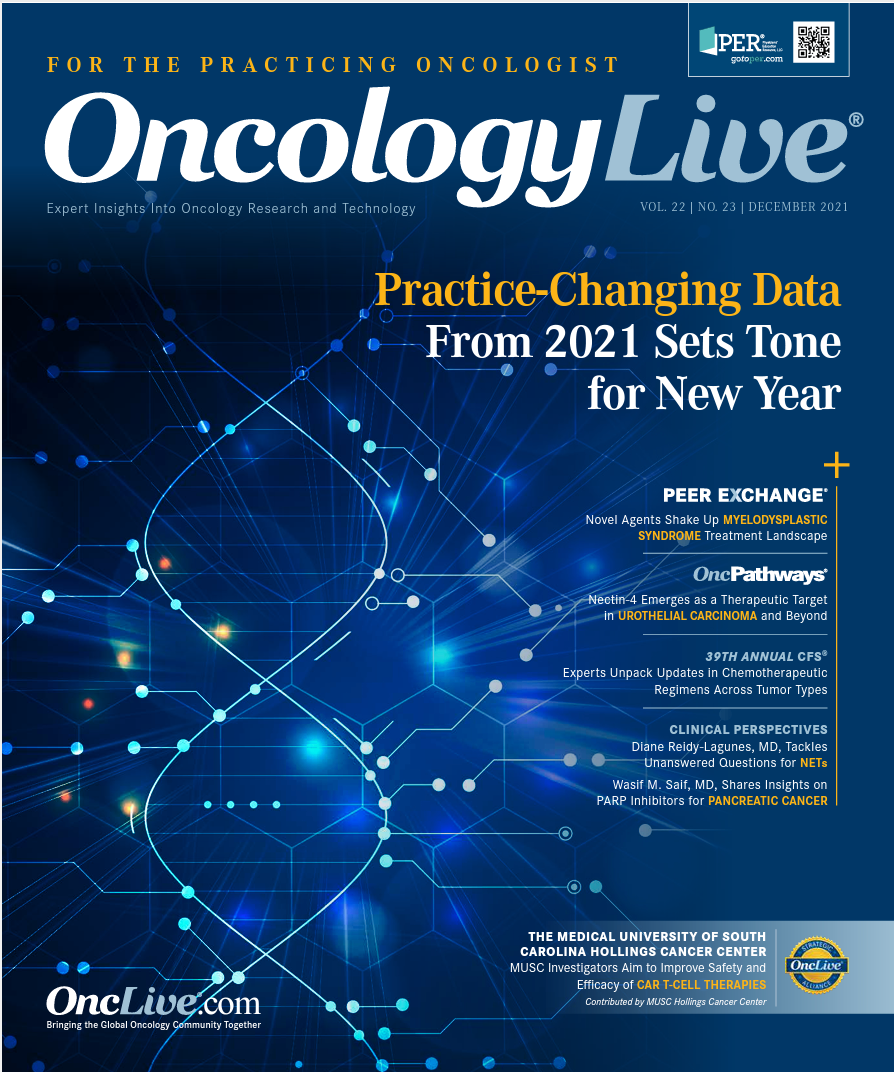Publication
Article
Oncology Live®
Pembrolizumab Combination Advances Standard of Care in TNBC
Author(s):
Peter Schmid, MD, PhD, discussed how this approval defines a new standard of care for patients with TNBC.
Peter Schmid, MD, PhD

Pembrolizumab (Keytruda) has added another indication to its already long list of clinical uses. On July 26, 2021, the FDA approved the PD-1 inhibitor for patients with high-risk, early-stage, triple-negative breast cancer (TNBC) in combination with chemotherapy as neoadjuvant treatment, and then continued as a single agent as adjuvant treatment after surgery.1
The approval was based on findings from the phase 3 KEYNOTE-522 trial (NCT03036488), which showed that patients treated with pembrolizumab plus chemotherapy (n = 784) experienced a pathological complete response (pCR) rate of 63% (95% CI, 59.5%-66.4%) compared with 55.6% (95% CI, 50.6%-60.6%) in patients receiving placebo plus chemotherapy (n = 390).2 In an interview with OncologyLive®, Peter Schmid, MD, PhD, a professor of medicine at Cancer Research UK Barts Centre in London, England, discussed how this approval defines a new standard of care for patients with TNBC.
OncLive®: What were the key takeaways from the KEYNOTE-522 data?
Schmid: [We already knew that] immune therapy could provide a benefit in TNBC. There was single-agent activity [with pembrolizumab] in metastatic TNBC trials, and results of randomized phase 2 trials showed a substantial benefit from adding immunotherapy to chemotherapy. It was clear from the metastatic studies that single-agent immunotherapy would not be the optimal strategy forward. [However, there was a] clear synergistic signal and a rationale to combine chemotherapy with immunotherapy because chemotherapy can upregulate CD8-positive cells and PD-L1.
[Chemotherapy] can also downregulate some of the inhibitory or regulatory T cells and, most importantly, it can lead to antigen release, which enables immunotherapy to work better. When we were designing [treatment strategies for] early breast cancer we were aware there was a clinical need to improve outcomes for patients with stage II and stage III TNBC. Neoadjuvant chemotherapy is the standard of care; therefore, it was a logical next step to combine neoadjuvant chemotherapy with pembrolizumab.
We saw a substantial, and meaningful increase in the rate of pCR with pembrolizumab compared with chemotherapy alone. In addition, according to the results of the primary analysis, after a median follow-up of 39 months, we saw that the addition of pembrolizumab significantly improved event-free survival [EFS]. The EFS rate was 84.5% with pembrolizumab vs 76.8% with [placebo]—that’s a substantial, important difference.
Another important observation is that the benefit of immunotherapy when looking at EFS seems to be consistent through all subgroups. That includes patients with node-positive or node-negative disease. Patients with stage II or stage III disease have the same relative benefit with the addition of pembrolizumab. Interestingly, patients with PD-L1–positive tumors have the same relative benef it as patients with PD-L1–negative tumors. These data are in clear contrast to what we saw in the metastatic setting, probably because of the higher plasticity of those tumors.
Additionally, a preplanned analysis examined EFS by pCR rate, looking at whether patients with immunotherapy do better than patients [who did not receive] immunotherapy. The patients who achieved pCR with the addition of pembrolizumab have a slightly better outlook with an EFS rate of 94.4% after 3 years compared with 92.5% [for those without pembrolizumab treatment]; the HR was approximately 0.7. Most importantly, if you look at the patients who had residual disease at the time of surgery, where one would be tempted to say the treatment didn’t work optimally, we saw a substantial benefit from immunotherapy. The 3-year EFS rate for patients with residual disease was 67.4% if they received immunotherapy and 56.8% for patients who received chemotherapy and placebo.
Looking at tolerability, most adverse effects [AEs] were consistent with what we know from checkpoint inhibitors given alone or in combination with chemotherapy. Most of the events observed during the study were chemotherapy-related, but there were also immune-mediated AEs consistent with the known profile. The most common AEs were endocrine changes and skin reactions [and] were mostly observed in the neoadjuvant phase. In the 6 months after surgery, when patients received pembrolizumab alone, there was a very low incidence of these AEs.
How does this approval potentially shift the treatment paradigm of TNBC?
For me, the KEYNOTE-522 data define a new standard of care for patients with stage II-III TNBC. This is a high-risk disease. We have been able to demonstrate that we didn’t just increase response rates but also can now improve long-term outcomes, reducing recurrences by nearly 40%. This is a massive step forward and should be a new standard of care, provided access is possible.
What does the future hold for this therapy in this patient population?
This trial has clearly established that immunotherapies should be part of therapy for patients with stage II/III disease. We don’t yet know what the role of immunotherapy may be [for patients with] stage I disease and trials are certainly warranted in this setting, especially as an option to de-escalate some of the chemotherapy if immunotherapy was added [to treatment for] patients with low-risk disease.
The second question we can’t address for now [with the] KEYNOTE-522 data is to what degree patients benefit from the 6-month adjuvant phase of the therapy. Now, we can only say 1 year of immunotherapy delivers benefit. How much of this [is attributable] to the first 6 months vs the second 6 months we don’t know. For patients who have achieved pCR, it’s certainly a consideration to see [whether] they may have a similar benefit if they only receive immunotherapy in the early setting.
A third question [regards] the chemotherapy strategy. [In KEYNOTE-522] we selected the most effective chemotherapy strategy, which has now been confirmed. [However], it is worthwhile to explore whether all patients will require this chemotherapy strategy and whether similar outcomes could be achieved with other chemotherapy strategies.
References
- FDA approves pembrolizumab for high-risk early-stage triple-negative breast cancer. FDA. Updated July 27, 2021. Accessed November 5, 2021. bit.ly/3mQntFK
- Keytruda. Prescribing information. Merck; 2021. Accessed November 5, 2021. bit.ly/3bIYDRB










